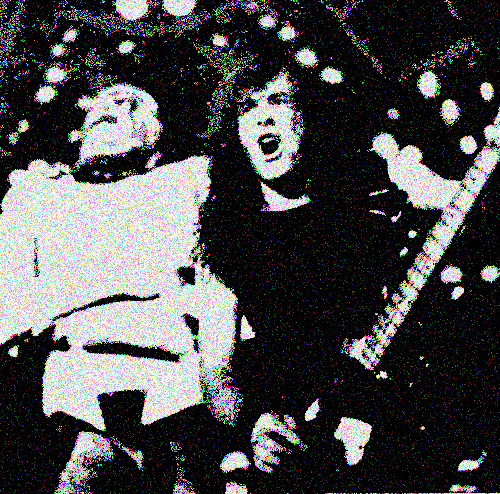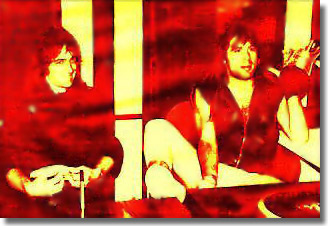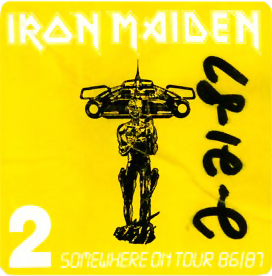
|
Search JoyZine with Google Site Search! |
Iron Maiden Interview by Kevin Thompson
Once upon a time, Steve Harris, like most English boys, dreamed of being a professional soccer player. But then one fateful day in 1971 he bought a Telecaster copy. It wasn't long before Steve had taught himself to play the guitar—and to write. Formed in London, England, in 1976, Iron Maiden was from the start the brainchild of Steve Harris (b. 12 March 1957, Leytonstone, London--bass), formerly a member of pub rockers Smiler. Named after a medieval torture device and a classic old film, The Man in the Iron Mask, the music was suitably heavy and hard on the senses. The heavy metal scene of the late '70s was widely regarded as stagnant, with only a handful of bands proving their ability to survive and produce music of quality. It was just at this time that a new breed of young British bands began to emerge. This movement, which began to break cover in 1979 and 1980, has become known as the New Wave of British Heavy Metal, or NWOBHM. Iron Maiden were one of the foremost bands in the genre, and many would say its definitive example. Younger and meaner, the NWOBHM bands dealt in faster, more energetic heavy metal than any of their forefathers (punk being an obvious influence). There were several line-up changes in the Iron Maiden ranks in the very early days, and come the release of their debut EP, the group featured Harris, Dave Murray (b. 23 December 1958, London--guitar), Paul Di'anno (b. 17 May 1959, Chingford, London--vocals) and Doug Sampson (drums). The group made its live debut at the Cart & Horses Pub in Stratford, east London, in 1977, before honing its sound on the local pub circuit over the ensuing two years. Unable to solicit a response from record companies, the group sent a three-track tape, featuring Iron Maiden, Prowler and Strange World, to Neal Kay, DJ at North London's hard rock disco, the Kingsbury Bandwagon Soundhouse. Kay's patronage of Iron Maiden won them an instant welcome, which translated itself finally into the release of The Soundhouse Tapes on the band's own label. The initial and only pressing of 5,000 sold out in 10 days--by mail-order. November 1979 saw the group add second guitarist Tony Parsons to the line-up for two tracks on the Metal for Muthas compilation, but by the time the group embarked on sessions for their debut album, he had been replaced by Dennis Stratton (b. 9 November 1954, London), and Sampson by Clive Burr (b. 8 March 1957--drums). A promotional single, "Running Free," reached number 34 on the charts and brought an appearance on the BBC program, Top Of The Pops. Refusing to mime, they became the first band since The Who in 1973 to play live on the show.
Iron Maiden was a roughly-produced album, but reached #4 in the album listings on the back of touring stints with Judas Priest and enduringly popular material such as Phantom of The Opera. Killers boasted production superior to that of the first album, and saw Dennis Stratton replaced by guitarist Adrian Smith (b. 27 February 1957). In its wake Iron Maiden became immensely popular among heavy metal fans, inspiring fanatical devotion, aided by blustering manager Rod Smallwood and apocalyptic mascot Eddie (the latter had been depicted on the cover of Sanctuary, standing over PM Margaret Thatcher's decapitated body). In October of 1980 Adrian Smith, a neighbor and schoolmate of Dave's, joined Maiden and took Dennis Traton's place, playing rhythm guitar. The second LP, Killers, was released in 1981. The Killer World Tour followed on the heels of the album's success and took them to Europe and, for the firt time, the U.S., Canada and Japan--to 15 countries over the course of an eight-month period. The Japanese concerts were recorded and five of the tracks were released in the U.S. on a mini album, Maiden Japan, in October 1981. At the end of the North American tour, Bruce Dickinson (Bruce-Bruce), then a member of Samson, took Paul Di'Anno's place as lead vocalist. A few weeks of rehearsal and it was off to Italy. The release of Number Of The Beast, released March 22, 1982, was crucial to the development of the band. Without it, Iron Maiden might never have gone on to be such a force in the heavy metal arena. The album was a spectacular success, the sound of a band on the crest of a wave. It was also the debut of former infantryman and new vocalist Bruce Dickinson (b. Paul Bruce Dickinson, 7 August 1958, Worksop, Nottinghamshire) replacing Paul Di'anno (who would go on to front Lone Wolf, Battlezone and Killers). Formerly of Samson, history graduate Dickinson would make his live debut with Maiden on 15 November 1981. Singles such as "Run to the Hills" and "The Number of the Beast" were big chart hits, Iron Maiden leaving behind their NWOBHM counterparts in terms of success, just as the movement itself was beginning to peter out. The album went to #1 in the U.K. and #33 in the U.S. Piece Of Mind continued their success and was a major hit in the USA (number 14). Clive Burr was replaced by Nicko McBrain on the sessions, formerly drummer with French metal band Trust, who had supported Maiden on their 1981 tour (he had also played in Streetwalkers). Piece Of Mind was not dissimilar to the previous album, showcasing the strong twin guitar bite of Murray and Smith, coupled with memorable vocal lines and a sound which fitted their air-punching dynamic perfectly. Single offerings, "Flight of Icarus" and "The Trooper," were instant hits, as the group undertook two massive tours, the four-month World Piece jaunt in 1983, and a World Slavery retinue which included four sellout dates at London's Hammersmith Odeon a year later. With the arrival of Powerslave in November some critics accused Iron Maiden of conforming to a self-imposed writing formula, and playing safe with tried and tested ideas. Certainly, there was no significant departure from the two previous albums, but it was nonetheless happily consumed by the band's core supporters, who also purchased in sufficient quantities to ensure chart hits for "Aces High" and "Two Minutes to Midnight." Live After Death was a double album package of all their best-loved material recorded live on their gargantuan 11-month world tour. By this time Iron Maiden had secured themselves an unassailable position within the metal hierarchy, their vast popularity spanning all continents. Somewhere In Time was a slight departure. It featured more melody than before, and heralded the use of guitar synthesizers. Their songwriting still shone through and the now obligatory hit singles were easily attained in the shape of "Wasted Years" and "Stranger in a Strange Land." Reaching #11 in the US, this was another million-plus seller.
Since the mid-'80s Maiden had been staging increasingly spectacular live shows, with elaborate lighting effects and stage sets. The Somewhere in Time tour (seven months) was no exception, ensuring their continued status as a live band, which had been the basis for much of their success. A period of comparative inactivity preceded the release of Seventh Son of a Seventh Son, which was very much in the same vein as its predecessor. A concept album, it still retained its commercial edge and yielded hit singles in "Can I Play with Madness," the surprisingly sensitive "Evil That Men Do" and "The Clairvoyant." After another exhausting, mammoth world trek, the band announced their intention to take a well-earned break of at least a year. Speculation abounded that this meant the dissolution of the band, exacerbated by Dickinson's solo project, Tattooed Millionaire, his book, The Adventures Of Lord Iffy Boatrace, and EMI Record's policy of re-releasing Maiden's single catalogue in its entirety (on 12-inch). After a considerable hiatus, news of the band surfaced again. Steve Harris felt that the direction pursued with the last two albums had been taken as far as was possible, and a return to the style of old was planned. Not wishing to pursue this game plan, Adrian Smith left to be replaced by Janick Gers (b. Hartlepool, Lancashire, England), once guitarist with White Spirit and Gillan (he had also contributed to Dickinson's solo release). The live show was also to be scaled down in a return to much smaller venues. No Prayer For The Dying was indeed much more like mid-period Iron Maiden, and was predictably well-received, bringing enormous hit singles with "Holy Smoke" and "Bring Your Daughter to the Slaughter." The latter, previously released in 1989 on the soundtrack to A Nightmare On Elm Street 5, had already been granted the Golden Raspberry Award for Worst Song in that year. Yet it gave Iron Maiden their first ever number 1. The obligatory world tour followed. Despite being denounced as "Satanists" in Chile, 1992 also saw the band debut at # in the charts with Fear of the Dark, which housed another major single success in "Be Quick or Be Dead" (number 2). However, it was to be Dickinson's swan song with the band, who invited demo tapes to be sent to them following his announcement that he would permanently depart, following current touring engagements. His eventual replacement was Blaze Bayley (b. 1963, Birmingham, West Midlands) from Wolfsbane. His debut album was X-Factor, and on this and at live gigs (which they only resumed in November 1995) he easily proved his worth. This was a daunting task, having to learn Maiden's whole catalogue and win over patriotic Dickinson followers. Smith resurfaced in a new band, Psycho Motel, in 1996. The following interview was recorded in Cleveland Ohio with Bruce Dickinson and Adrian Smith before the band's World Piece tour: Q: Bruce, you joined Iron Maiden in September of '81, just after the Killers tour... BRUCE: Yes, it was after Paul Di'Anno had left the band. The rest of the band members had welcomed me by locking me in a rehearsal studio so I could learn the set, and then we were off to Italy in October for my first live work with Iron Maiden. Q: What was the first band you were in? BRUCE: My first excuse for a band was while I was at school. I had a pair of bongos. We did "Smoke on the Water," and I used to beat the crap out of those bongos because we didn't have a drum kit. The band realized that the singer couldn't sing, so I got the job (mainly to stop the noise of the bongos)! We played in each other's bedrooms, annoying our mums and dads. Q: How did you come about joining Samson? BRUCE: I saw an ad in a local paper wanting a singer for recording. Together, we put down a song called "Dracula" and called the band Shots. I was then working as the social secretary at the college, and Manfred Mann's Earth Band was going to play, so I put Shots down to play, and that's when the guys from Samson heard me sing. Q: Which do you prefer, touring or recording? DAVE: I enjoy both, but touring is more fun, and I get off better when I'm playing to a live audience. Q: I hear that one of your guitars belonged to Paul Kossof. How did you come about owning it? DAVE: I bought it from an ad in the papers. (Other than that, I have] three Fender Stratocasters and an Ibenez Destroyer I picked up on tour. Q: Which is your favorite guitar? ADRIAN: My Les Paul. Q: And your favorite Maiden song? STEVE: "Phantom of the Opera" and "Murders in the Rue Morgue". Q: What about non-Maiden tracks? STEVE: "Love to Love" by UFO. Q: What's the venue you like playing the most? STEVE: Any industrial area in Britain. Q: It seems that the band doesn't have so much a "sound"—an "Iron Maiden sound"—but rather a style which has developed as each member has become more comfortable with his role. On the new album, Piece of Mind, there seems to be more emphasis from each individual member. STEVE: Well, on the Killers album, Adrian was very new and it really wasn't until he'd been with the band about a year-and-a-half that he really felt he was a full member. He always had been, but he never really seemed to accept that it was happening. (Perhaps] because he went from a local band in the East End to Iron Maiden, which, even at the time, was quite a big act. It took him quite a while to settle in, and it also took both he and Dave a long time to get the right guitar sounds. Even on the last tour, which was the second world tour, they were still changing equipment at various intervals to get the sound they were looking for…because they're both perfectionists when it comes to sound. Then, Bruce came in and he really did fine things for the band too. As the tour progressed last year, we just gelled more and more as a band. And I think on this album, because Bruce has been with the band awhile and also was very involved with the writing, he's more relaxed. So the vocal performance is tremendous. He's so quick in the studio because his ear for pitch is so good; he just gets up there and bang, it retains a great live feel. The other really big difference is the new drummer, Nicko, because his drumming is some of the best rock drumming there is. His feel is magic. Nicko toured with us when he played with the French band Trust in 1981 and '82. So he's been on the road with us. Trust and Iron Maiden have always been big friends anyway, and personality-wise there was no problem. He was actually born about a mile and a half from me, and he's just a couple of years older than I am. His drumming, I think, has given us a different dimension. It's tougher, and his timing is perfect. He's a total rock drummer; he's got a great feel and he hits it real hard. So the whole thing's grow up. Every album's improved both in term of production and musicianship. I think now it's really becoming what Iron Maiden is all about, and we expect it's going to develop even more from here. Q: What influence has producer Martin Birch had on Maiden? STEVE: The reason we use Martin is that he puts down the sound that we want, the way we like it. And we think the first three albums were really leading up to this one in terms of quality. In general, bands are being given producers that make the music for them and, in some cases, even co-write it. With Martin, that's not the case at all and never has been. What Martin has always added with us is his expertise in the studio and his great ability at recording our sounds. We've only just come to this point in our drum and guitar sounds, which are exceptional now; it's just a team growing up together. Martin's also become aware, obviously, with the experience of working with us, of the way we want to proceed. The suggestions going both ways are very fluid, so Martin's very much a part of the band in the studio. Q: With the World Piece tour underway, what's left on the itinerary? ADRIAN: After the US, we end up in Canada on October 16, then we go to France, Germany, Switzerland, Spain, Portugal, Italy, Austria and Yugoslavia. We're quite willing to keep coming over and touring because it's the touring that we enjoy most. You can't play 180 concerts a year all around the world unless you really enjoy the gigging and the travel. |


